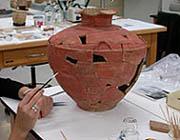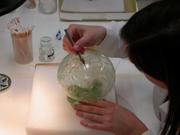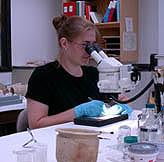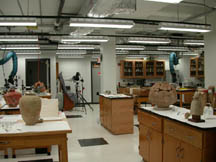 Conservation is the profession dedicated to the study and preservation of material culture. Conservation professionals examine, study, and make recommendations for the proper care and storage of cultural material. When necessary, a conservator will carry out treatments to stabilize and preserve fragile, deteriorating material. All treatments are completely documented and the conservation records are considered archival documents.
Conservation is the profession dedicated to the study and preservation of material culture. Conservation professionals examine, study, and make recommendations for the proper care and storage of cultural material. When necessary, a conservator will carry out treatments to stabilize and preserve fragile, deteriorating material. All treatments are completely documented and the conservation records are considered archival documents.
The role of preventive conservation is key to the modern practice of conservation. Preventive conservation attempts to maintain a stable, inert atmosphere for the objects in order to slow down the natural rate of deterioration. As the immediate environment is modified to enhance the stability of the artifacts, the need for intervention is minimized.
The ISAC Conservation Laboratory is devoted to the conservation of three-dimensional archaeological objects. Archaeological materials include metals, stone, ceramics, and glass, as well as organic materials such as wood, bone, ivory, leather, and plant matter.
A Brief History of the ISAC Conservation Laboratory
 The ISAC Conservation Laboratory was founded in 1974 with funding from the Women's Board of the University of Chicago. Barbara Hall, the first professional museum conservator at ISAC, was responsible for establishing the original conservation laboratory at ISAC. During her tenure at ISAC, conservation as a profession was firmly established. For the first time, treatments were documented and appropriate conservation record photographs were maintained. Additionally, over a dozen pre-program and post-graduate interns passed through the laboratory.
The ISAC Conservation Laboratory was founded in 1974 with funding from the Women's Board of the University of Chicago. Barbara Hall, the first professional museum conservator at ISAC, was responsible for establishing the original conservation laboratory at ISAC. During her tenure at ISAC, conservation as a profession was firmly established. For the first time, treatments were documented and appropriate conservation record photographs were maintained. Additionally, over a dozen pre-program and post-graduate interns passed through the laboratory.
In 1998, after nearly two years of a major renovation and construction project which provided the museum and storage areas with climate control, the conservation laboratory was relocated to the second floor of the ISAC's new wing. This new laboratory has approximately 1600 square feet of space (nearly 4 times the size of the original laboratory), with a separate office and cleaning room. The new laboratory has a greatly improved localized exhaust system as well as a more general exhaust system in the cleaning room and additional equipment.


